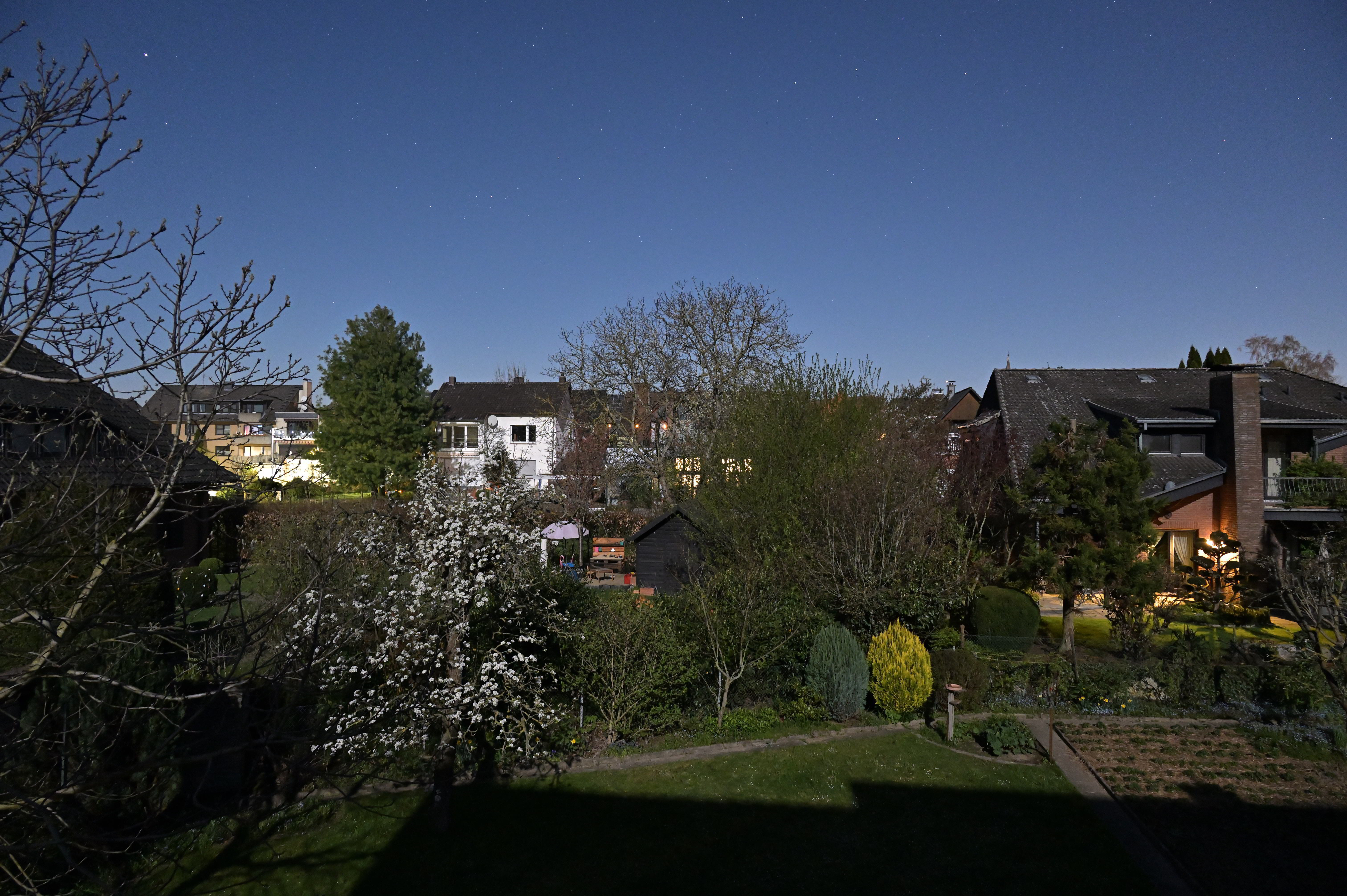#backyardastronomy


Man sollte besser vorbereitet losziehen!
OK, Wecker war richtig gestellt - UTC Angabe berücksichtigt: Aufgang also 7:09 und Ausschau gehalten...
Aber ohne Kompass anhand des Monds 101° abschätzen, zuerst zu weit östlich gesucht.
Wollte schon die aufziehenden Wolken verantwortlich machen, aber dann doch noch etwas "weiter" rechts geschaut, knapp 2° Höhe.
Uff, und da war er!
Nur für ein Bild, dann wurde er schon von der Schleierbewölkung verdeckt.
Und wieso habe ich nicht das 600er mitgenommen??!!
Naja, Mitte Oktober kommt er ja wieder...
#foto mywork #backyardastronomy #Komet #C/2023_A3_(Tsuchinshan-ATLAS) #200mm

Beim Mond ist es gestern Nacht (22:01) glücklicherweise nicht geblieben.
Nachdem ich das Mondbild bearbeitet hatte schaute ich auf die Polarlicht-App und: alles lila!
Also raus auf den Balkon (22:50) und man konnte mit bloßem Auge das rote Polarlicht oberhalb des Mondes sehen. Die Familie zusammengerufen und den Gassi-Nachbar aufmerksam gemacht. Wir waren ganz schön begeistert. Ein paar Fotos sind auch entstanden. Ich musste erst noch das 20mm Objektiv raussuchen. Kurz nach 11 war es dann erst mal vorbei.
Also habe ich mich in das Dachbodenfenster gestellt und gewartet, das konnte doch noch nicht alles gewesen sein - bei der Datenlage.
In der nächsten Stunde zeigten sich am Horizont relativ konstant eine grüne, flächige Verfärbung...
Und dann, kurz nach Mitternacht, ging dann das Schauspiel los - gut dass es Speicherkarten gibt!
Die aufziehenden Wolken hatten ein Einsehen und haben sich die Stunde zurückgehalten, bis es vorüber war.
Hier ein stellvertretendes Bild von mir der #auroraborealis.

Gestern Abend dann doch noch Glück gehabt, zwischen den Wolken...
Leider sind die Galileischen Monde vom Mond überstahlt.
Da hatten die Wolken heute eine Einsicht. Die #partielle #Mondfinsternis konnte mit #Jupiter beobachtet werden!


Zur heutigen #ObservetheMoon Nacht.
Wenn ich so auf den Wetterbericht sehe, wird das nix mit einem aktuellen Bild.
Daher was aus der Konserve.
It's a clear #night and #Jupiter and #Venus are bright in the #western #sky and getting closer together in their apparent positions. This is a #photograph of the pair with a 1.6 s exposure. It is also difficult to get a sharp #focus manually as autofocus doesn't really work with objects at infinity and yet effectively points of light. This taken with a 400 mm #telephoto #lens.

Also with long exposures and a heavy lens, even a the tiniest #vibration on the tripod can blur the image, even with the sharpest focus. Here's the same image but cropping around Jupiter. You can see its four biggest satellites, (left to right: #Europa, #Io, #Ganymede and #Callisto, information courtesy of #Stellarium)

#MyWork #MyPhoto #CCBYSA #DSLR #Nikon #D7000 #Winter #BackyardAstronomy #JovianSystem #Moons

Morgens um 10 vor Acht ist die Welt noch in Ordnung - #Mond und #Antares leiten einen zur Arbeit (rechts liegen lassen!) und die #Sonne lauert verheißungsvoll hinter dem Horizont :-)
A huit heures moins dix du matin, le monde est encore en ordre - la #Lune et #Antarès vous guident vers votre travail (laisser à droite !) et le #Soleil vous guette, plein de promesses, derrière l'horizon :-)
In the morning at 10 to eight, all is still right with the world - #Moon and #Antares guide you to work (leave it to the right!) and the #Sun lurks auspiciously behind the horizon :-)

Für alle, die heute bedeckten Himmel haben: der #Mars und der fliehende #Komet :-)
#C/2022_E3_(ZTF) #Komet #Comet #backyardastronomy #astronomie #600mm

Nach dem ganzen bisherigen Wolkendebakel heute mal Butter bei die Fische und trotz fast vollem Mond und leichten Schleierwolken mal das 600er draufgehalten...
Dabeisein ist alles :-)
#C/2022_E3_(ZTF) #Komet #Comet #backyardastronomy #astronomie #600mm
A #terrestrial demonstration of why it's just about impossible to see the #Moon's surface and #stars simultaneously. Tonight the Moon and #Jupiter (a wandering star or #planet) are in #conjunction -- well just about. And here are two images taken with two different #exposure time.
The first is with a #ShutterSpeed of 1/6 s. The lit part of the Moon is a white featureless blob but, because it's a #misty #night, there's a wonderful #ice #halo which shows #colours from the #VisibleSpectrum. You can see Jupiter directly above.

Next, with a shutter speed of 1/100 s, the #surface of the Moon shows much more contrast but you can barely see Jupiter. Also, the #fog is also invisible.

#MyWork #MyPhoto #CCBYSA #DSLR #Nikon #D7000 #Autumn #BackyardAstronomy

#Alkor fährt auf #Mizar mit dem #Großen_Wagen durch die nächtlichen #Wolken - gute Nacht :-)
#Mywork #foto #photo #backyardastronomie #backyardastronomy #astronomie #astronomy #BadMeingarten #Nikon

Die #Birne blüht gerade herrlich, was auch bei #Ostervollmond gut zu sehen ist.
#Mywork #foto #photo #backyardastronomie #backyardastronomy #astronomie #astronomy #Vollmond #moon #BadMeingarten

Lune d'équinoxe / Equinox Moon
Sonne au cadran d'or
Le printemps déjà fleuri
La prochaine à Pâques
Golden orb has rung
For already bloomy spring
Next one for Easter
#photo #photographie #photography #Nikon #maphoto #myphoto #mywork #CC #BY-NC-ND 4.0
#lune #moon #astronomie #astronomy #backyardAstronomy
#haiku #HaikuDominical #HaikuSunday
#bonneNuit #goodNight






